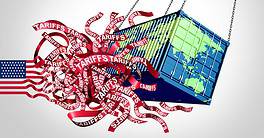Corporates and agent banks had a traditionally distant relationship. Not anymore.
In the ever-evolving landscape of global finance, the once-muted lines of dialogue between corporates and sub-custodians have transformed into a vibrant exchange. As Richard Anton, chief client officer at CIBC Mellon, tells it, the most fundamental aspects of sub-custodianship have remained somewhat consistent over the years. Sub-custody providers like Toronto-based CIBC Mellon possess robust operational capabilities, strong connectivity to support effective cross-border processes, and deep local knowledge.
But in 2024, the environment within which sub-custodians function has become more complex. Geopolitical tensions, like Sino-US trade conflicts and the Russia-Ukraine war affecting energy markets and supply chains, combined with technological advancements such as artificial intelligence and blockchain, and a tangle of new regulatory demands significantly complicate and heighten the day-to-day competitiveness of global finance.
Corporates are no longer keeping quiet. They’re actively seeking out sub-custodians for their expertise in meeting these challenges.
As a result, “the relationship between sub-custodian firms and corporates has become more collaborative and strategic over the years,” says Anton. “Traditionally, sub-custodians were seen primarily as service providers handling transactional aspects of custody. However, in 2024, this relationship has evolved into a partnership where sub-custodians are viewed as key advisers in managing and optimizing the safekeeping and servicing of assets.”
Corporate brass increasingly rely on sub-custodians for insight into market developments, regulatory changes, and risk management strategies. There is also a growing expectation that sub-custodians support value-added services such as data analytics, environmental/social/governance (ESG) reporting, and digital assets like recently approved bitcoin exchange-traded funds.
“Anecdotally, we have seen instances where corporates have engaged with sub-custodians to develop bespoke solutions for their unique needs,” Anton notes. “For example, a corporate client might collaborate with a sub-custodian to implement a customized reporting framework that integrates ESG metrics, helping them meet investor demands for greater transparency and sustainability.”
Some Big Banks Step Back
Earlier this year, JPMorgan Chase decided to hand over its local custody operations in Taiwan to Standard Chartered. Despite being touted as the third-largest global custodian, the New York-based banking giant simply couldn’t hack it at the local level in East Asia—7,800 miles away.
Yes, JPMorgan routinely handles cross-border deals. But local custody is a different beast. With a whopping $520 billion in assets under management as a local custodian in North Asia, JPMorgan decided it was better off outsourcing services to a firm with a better sense of the goings-on across the region.
It was a “mandate win,” says Margaret Harwood-Jones, global head of Financing and Securities Services at Standard Chartered, that “significantly demonstrates the success of our focus and strategy in connecting our clients to local markets to support their business agendas, while delivering client-centric solutions that we can scale across the markets and relationship with our clients.” Standard Chartered is now “the top [foreign institutional investor] custodian in Taiwan,” she adds.
JPMorgan retreated from Hong Kong and Australia, too, but has kept its fingers in the global pie by selecting HSBC to provide sub-custodian services in Hong Kong and Taiwan. It isn’t yet known which sub-custodian is stepping in for Morgan in Australia. But the bank’s strategic retreat highlights a growing realization: that the biggest global custodians sometimes just can’t handle the local flavor of certain markets.
JPMorgan, just as it does in Asia-Pacific with Standard Chartered and HSBC, has secured the help of UniCredit in the Czech Republic and the Central Eastern Europe region.
“The contractual setup is always between GC and sub-custodian,” says Júlia Barbara Romhányi, global head of Securities Services at UniCredit. “In this respect, GCs act on behalf of the corporate client and manage their assets with the sub-custodian.”
So, in the Czech Republic, it’s JPMorgan’s responsibility to monitor and mitigate risks associated with doing business in a certain region by picking the right sub-custodian, Romhányi explains.
Northern Trust and Societe Generale Securities Services, too, leverage an extensive network of sub-custodians to manage assets across multiple jurisdictions. That way, they can focus on their core global custody services. By tapping sub-custodians, the bigger firms can streamline operations and reduce costs without having to stress about the regulatory demands of countries they don’t know enough about.
In other words, sometimes you have to let go of the local to keep your global game strong.
Key Challenges and Changes
The history of sub-custodianship in global finance has always been shaped by the evolution of international trade and investment. By the early 2000s, regulatory shake-ups like the US Securities and Exchange Commission’s Rule 17f-7 were placing more responsibility on global custodians to oversee sub-custodians, particularly in emerging markets.
Then there was the 2008 global financial crisis, which underscored the importance of robust custody services. In the years that followed, scrutiny of sub-custodians’ role in safeguarding assets has increased, leading to stricter regulatory frameworks and higher standards of operational due diligence.
GCs are conducting due diligence on their sub-custodian network “on a regular basis,” Romhányi notes. “They have the fiduciary duty [of] acting in the best interest of their clients, ensuring the safekeeping of the assets, adhering to all relevant regulatory requirements.”
Sub-custodians now find themselves on the verge of sweeping change once again.
“In the fast-paced world of finance, the role of sub-custodians has evolved significantly over the years,” Thompson says. “As we are midway through 2024, several key changes and challenges have emerged, reshaping the sub-custody landscape.”

Chartered: Standard Chartered is now
the top custodian for foreign institutional
investors in Taiwan.
This time, the technological advancements are far more daunting than the ones that preceded them. That includes finding ways to leverage AI and electronic ledgers like the blockchain to enhance operational efficiency and security, according to Alexis Thompson, BBVA’s head of global securities services.
The integration of advanced technology like AI algorithms will facilitate better data analytics, risk management, and decision-making processes, Thompson predicts. It’s something BBVA has already begun exploring, along with blockchain, advanced encryption methods, and multifactor authentication: all to safeguard systems.
“This technological evolution is helping reduce manual errors and operational risks, providing a more reliable and efficient service to clients,” Thompson says. “From technological advancements to regulatory shifts, the sub-custodian’s job today is markedly different from what it was even a few years ago.”
Regulatory changes are once again affecting sub-custodians profoundly. The European Union’s Central Securities Depositories Regulation (CSDR), for instance, requires sub-custodians to maintain higher levels of transparency, report more detailed information, and ensure better protection of client assets.
“These regulatory requirements have driven sub-custodians to invest heavily in compliance technology and processes,” Thompson says.
Sub-custodianship, in other words, has evolved from a bundle of informal arrangements to a critical, high-tech component of global finance. And the role of the sub-custodian can be expected to continue morphing as financial markets become ever more interconnected.
Corporates’ involvement at this level is deepening as well. While they do not have a direct say in selecting specific sub-custodians, they set criteria and expectations for their global custodian as it makes these choices, according to CIBC’s Anton.
“Corporates can ensure through their own due diligence that the global custodian maintains a proven robust process for the selection and monitoring of its sub-custodians,” he says. “Corporates often engage in regular reviews and maintain open communication with their global custodians to ensure that their standards and requirements are being met throughout the custody chain.”




